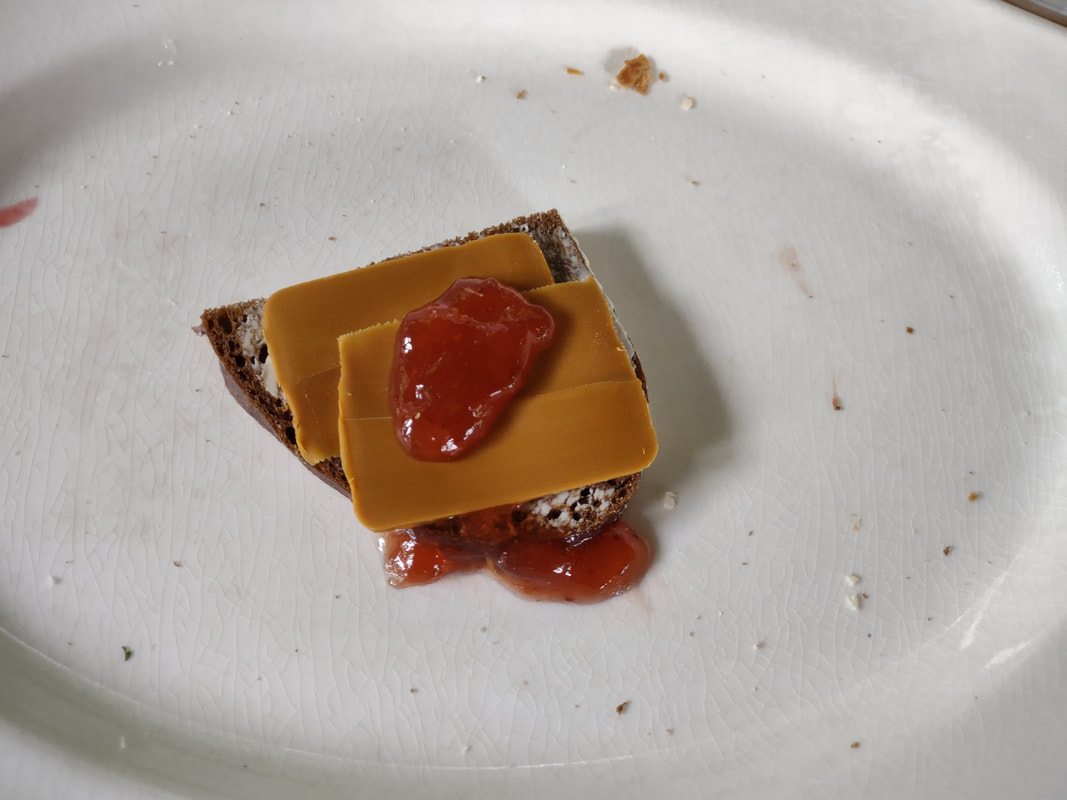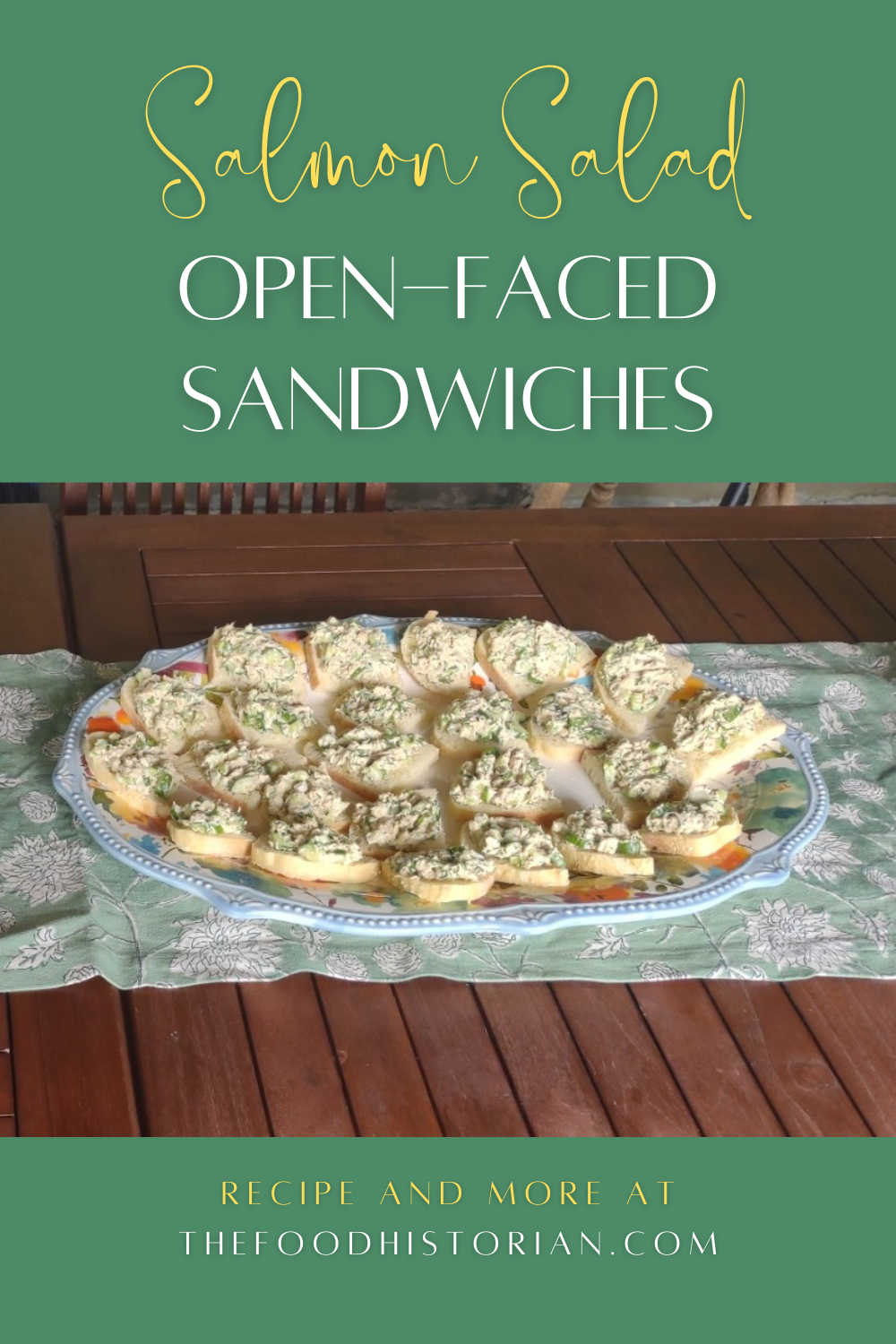|
These were, shockingly, the runaway smash hit of my Scandinavian Midsummer Porch Party. And here I thought no one would like them! But they were the first to go of the open-faced sandwiches on offer and the only ones to have every last sandwich devoured. I probably should have made more... You may be asking yourself, what the heck is a "Ski Queen Brunost Open-Faced Sandwich?" Dear reader, Ski Queen is a brand of brunost widely available here in the United States. And what exactly is brunost? And how is it different from gjetost? Did you even know you needed the answers to these questions? Brunost is literally Norwegian for "brown cheese," and it is a very special, very specific style of cheese that is not really a cheese at all. Made from caramelized whey, this super-smooth, sweet and salty cheese can be made from either cow's milk whey (brunost) or goat's milk whey (gjetost). Whey-based cheeses, or mysost, date back over 2,000 years in Scandinavia, with the earliest evidence found on Jutland, Denmark. Going back hundreds of years, Norwegian dairy farmers perfected the use of whey, the milky yellow liquid leftover from processing butter. The original brown cheese, mysost, was literally just whey boiled until all the water evaporated and it caramelized into a sweet, grainy, fudge-like substance. But brunost is cow's milk whey that has cream and milk added in, which makes it creamy, smooth, and addictive. This addition is attributed to dairywoman Anne Hov, who helped revive the failing dairy industry in Gudbrandsdalen, Norway, in the 1860s. Later variations included goat's milk (gjetost) and "ekte gjetost" or "real goat cheese" is a brown whey cheese made from only goat's milk whey and goat's milk - it has a much stronger flavor than brunost and a sweet-salty tang. Brunost was typically served with open-faced sandwiches, on Norwegian heart-shaped waffles, or eaten plain as a snack. Modern cooks have used it in all sorts of ways, but one of my favorites is a creamy gjetost sauce for chicken. Today, most commericial brunost is produced by Tine - a Norwegian dairy cooperative that started in the 1850s and is named after the special bentwood boxes Norwegians used to store butter in the days before refrigeration. Tine also produces Jarlsberg. In the United States, you can get the cow's milk brunost and goat's milk ekte gjetost under the Ski Queen brand, so named because of the association in Norway of brunost with skiing, since brunost holds its shape under a wide range of temperatures, and its sweetness and fat helped replenish energy after a long day of skiing. Brunost Open-Faced SandwichesThis really will win converts. If you want to be bold, have a tasting of both the milder, sweeter brunost and bolder gjetost. thinly sliced buttered rye sliced brunost a dollop of strawberry jam You'll need your ostehøvel to get appropriately thin slices - a knife will be too thick. Make sure to get high quality strawberry jam - not too sweet, not too thick (my favorite is Welch's natural strawberry). These little sandwiches are basically like grownup candy. You can see why they are so popular in Norway and why almost everyone who tries it loves brunost. Have you ever tried it? The Food Historian blog is supported by patrons on Patreon! Patrons help keep blog posts like this one free and available to the public. Join us for awesome members-only content like free digitized cookbooks from my personal collection, e-newsletter, and even snail mail from time to time! Don't like Patreon? Leave a tip!
0 Comments
When planning the menu for my Scandinavian Midsummer Porch Party, I wanted to make sure to have some sandwiches hearty enough to stand in for dinner. We can't all subsist on salads and dessert! But while these sandwiches are decidedly NOT friendly to folks who don't eat pork or meat (always make sure all guests can eat!), they are delicious and worth a try for those of you who do eat pork. Although many people don't realize it, ham is quintessentially Scandinavian. It is a popular Christmas and Easter dish, and the Danish pork industry supplies most of Continental Europe. We always had ham for Easter growing up, and sometimes for Christmas, too (along with Swedish meatballs). It's also a popular sandwich meat in the United States, where deli-style hams are very similar to those produced in Denmark. Jarlsberg is also a popular Scandinavian cheese here in the U.S. A Swiss-style cheese introduced to the dairy farms of Jarlsberg, Norway in the 1850s, it had disappeared by the 20th century. In the 1950s, scientists at the Agricultural University of Norway were intrigued by a graduate student's paper on the historic cheeses of Vestfold, Norway (where Jarlsberg is located) and set about to recreate the historic Swiss-style cheese. Rich and very butter, with extra-large holes, Jarlsberg is coated in red wax and the details of its production are a trade secret. Combining the two on pumpernickel rye with a dollop of lingonberry jam seemed like a match made in heaven, and I was right. Lingonberries, also sometimes known as partridgeberries or cow berries, are a relative of the cranberry. Lingonberries are native to the boreal forests of Scandinavia and the rest of Northern Europe, Russia, Alaska, Canada, etc. Tiny and tart, they feature heavily in Scandinavian cuisine, especially with game meats and in desserts and drinks. If you can't find lingonberry jam, you can substitute cranberry sauce, but it won't be the same. Ham and Jarlsberg Open-Faced Sandwiches with Lingonberry Jamthinly sliced sturdy pumpernickel bread butter shaved natural ham Jarlsberg cheese lingonberry jam or preserves Butter a slice of pumpernickel or rye bread thinly, edge-to-edge, and top with a slice or two of natural (I prefer bone-in) ham. Add a slice or two of Jarlsberg on top (use a Norwegian osthovel for best results!) and top with a small spoonful of lingonberry jam. The salty, fattiness of the ham, the buttery taste of the Jarlsberg, and the acid sweetness of the lingonberry jam work just wonderfully together. Plus they're pretty, too! You can serve these as part of a smorgasbord, like I did, or alone for a fancy lunch. The bread tends to dry out if left out too long, so if you have any party leftovers, be sure to seal and refrigerate to ensure freshness. I like to make the leftover open-faced sandwiches (if there are any!) closed by simply placing to of them together, open faces in! The Food Historian blog is supported by patrons on Patreon! Patrons help keep blog posts like this one free and available to the public. Join us for awesome members-only content like free digitized cookbooks from my personal collection, e-newsletter, and even snail mail from time to time! Don't like Patreon? Leave a tip! Salmon is a classic Scandinavian dish. Spring salmon runs up the fjords and rivers of Scandinavia from late May/early June through most of the summer. Salmon is eaten fresh, but it is also made into gravlax, a mild cold-cured dish made by burying whole salmon filets in a mixture of salt, sugar, and herbs. Salmon also features in many New England summer traditions, including Fourth of July menus, which consisted largely of salmon, new potatoes, and fresh peas. Historically, as with many springtime fish runs, salmon was inexpensive and easy to obtain, both in the United States and Scandinavia. Not so anymore. I wanted to serve salmon at my Scandinavian Midsummer Porch Party, but I was also short on time and feeding a crowd. I decided against the more intensive prep of a poached or grilled salmon filet and settled on the easier and more wallet-friendly canned salmon instead. I use the smaller tins of sustainably harvested wild-caught salmon that don't contain any skin or bones. The inspiration for this recipe came from a historic one I saw a while ago. Linda Hull Larned's One Hundred Picnic Suggestions cookbook, published in 1915, had a recipe for Salmon Salad which called for the use of rice, but offered an alternative of hard boiled eggs and cucumber. Since I was already making deviled eggs, I decided to go a little lighter and use just cucumber. Salmon Cucumber Salad Open-Faced SandwichesThis recipe makes a lot of sandwiches (enough for all of the ones pictured above), so feel free to cut the recipe in half if you're serving fewer people. 2 cans (5 oz. each) salmon 1 cup finely chopped English cucumber 2 scallions, sliced fresh dill, minced lemon juice or white wine vinegar salt pepper 1 tablespoon Dijon mustard mayonnaise Drain and flake the salmon, then stir in the cucumber, scallions, and fresh dill. Add salt and pepper and a splash or two of lemon juice or white wine vinegar and toss to coat. Stir in Dijon mustard and mayonnaise to coat. Serve on thin slices of fine-grained but sturdy white bread (I used semolina batard). You should probably butter your bread slices - I didn't, thinking the mayonnaise was moist enough, but they got a little soggy! You could also serve on toast or with water crackers. If you can't find or don't like salmon, you could certainly substitute tuna. But if you don't generally like tuna salad, give salmon salad a try! It is milder-tasting and the cucumbers give a refreshing crunch. If you wanted to be extra-fancy, you could certainly also use leftover grilled, poached, or roasted salmon, flaked, although be aware that most modern salmon filets are going to be fattier than canned salmon, so keep that in mind, flavor-wise. The Food Historian blog is supported by patrons on Patreon! Patrons help keep blog posts like this one free and available to the public. Join us for awesome members-only content like free digitized cookbooks from my personal collection, e-newsletter, and even snail mail from time to time! Don't like Patreon? Leave a tip! |
AuthorSarah Wassberg Johnson has an MA in Public History from the University at Albany and studies early 20th century food history. Archives
July 2024
Categories
All
|








 RSS Feed
RSS Feed